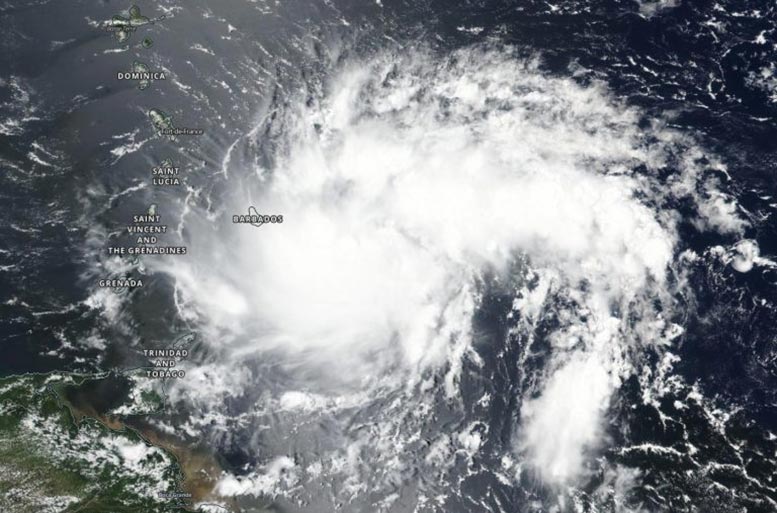
NASA-NOAA’s Suomi NPP satellite passed over the western North Atlantic Ocean and captured a visible image of Tropical Storm Dorian approaching the Leeward Islands on August 26, 2019. Credit: NASA Worldview, Earth Observing System Data and Information System (EOSDIS).
The Leeward Islands are a group of islands in the eastern Caribbean Sea, where the sea meets the western Atlantic Ocean. The Leewards extend from the Virgin Islands east of Puerto Rico, southeast to Guadeloupe and its dependencies.
The Visible Infrared Imaging Radiometer Suite (VIIRS) instrument aboard Suomi NPP provided a visible image of the storm on August 26, 2019. The VIIRS image showed the storm had taken on somewhat of a comma shape. That shape and the storm’s thunderstorm pattern changed over the course of the day because dry air moved into mid-level areas of the storm, suppressing thunderstorm development. A tropical cyclone is made up of hundreds of thunderstorms, so when development is inhibited, it affects the storm’s strength and sometimes the shape of the storm, depending on the direction from which the dry air comes.
By 5 p.m. EDT on August 26, the National Hurricane Center said, “Although the inner-core convection has decreased recently, a recent burst of strong convection (rising air that forms thunderstorms) with cloud tops colder than minus 80 degrees Celsius [indicating powerful thunderstorms with the potential to generate heavy rainfall] has redeveloped just north of the low-level center.”
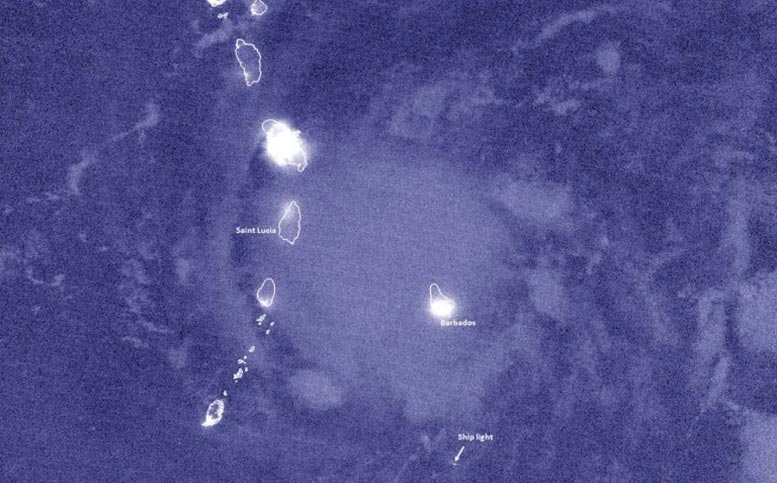
At 1:06 a.m. EDT (0506 UTC) on August 27, the Suomi NPP satellite passed over Dorian again, and viewed the storm at night and obtained high resolution infrared-band imagery. The nighttime image showed that Dorian appeared to be relatively compact in size with a few overshooting cloud tops and some tropospheric convective gravity waves. Credit: NASA/NOAA/UWM-SSEC-CIMSS/William Straka III
At 1:06 a.m. EDT (0506 UTC) on August 27, the Suomi NPP satellite passed over Dorian again, viewed the storm at night, and obtained high-resolution infrared-band imagery. The nighttime image showed that Dorian appeared to be relatively compact in size with a few overshooting cloud tops and some tropospheric convective gravity waves.
The nighttime image was created by William Straka III, a researcher at the University of Wisconsin – Madison, Space Science and Engineering Center (SSEC Cooperative Institute for Meteorological Satellite Studies (CIMSS). “The Waning Crescent moon, with 12 percent illumination didn’t show many features,” Straka said. “Even with airglow present, though one could see the city lights peeking through the clouds and a lone ship on the southern edge of the storm.”
By August 27, Dorian moved across St. Lucia and into the eastern Caribbean Sea bringing tropical storm-force winds with it. NHC said the Caribbean composite radar data show that Dorian remains a very compact system and that it still lacks a well-defined inner core.
The National Hurricane Center or NHC posted many watches and warnings on August 27. A Hurricane Watch is in effect for Puerto Rico, the Dominican Republic from Isla Saona to Samana. A Tropical Storm Warning is in effect for Martinique, St. Vincent and the Grenadines, and Puerto Rico. A Tropical Storm Watch is in effect for Dominica, Grenada and its dependencies, Saba and St. Eustatius, the Dominican Republic from Isla Saona to Punta Palenque, and the Dominican Republic from Samana to Puerto Plata.
At 8 a.m. EDT (1200 UTC) on Tuesday, August 27, NOAA’s National Hurricane Center or NHC noted the center of Tropical Storm Dorian was located by surface observations and Martinique radar data near latitude degrees 14.0 North and longitude 61.2 West. That puts the storm’s center just 15 miles (25 km) west-northwest of St. Lucia.
Dorian is moving toward the west-northwest near 13 mph (20 kph), and this motion is expected to continue through tonight, followed by a turn toward the northwest on Wednesday.
Maximum sustained winds are near 50 mph (85 kph) with higher gusts. Slow strengthening is forecast during the next 48 hours, and Dorian is forecast to be near hurricane strength when it moves close to Puerto Rico and eastern Hispaniola.
NHC said, “On the forecast track, the center of Dorian will move across the eastern and northeastern Caribbean Sea during the next few days, passing near or south of Puerto Rico on Wednesday [August 28], move near or over eastern Hispaniola Wednesday night, and move north of Hispaniola on Thursday [August 29].”

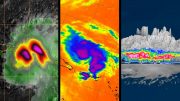
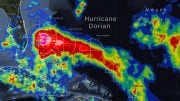
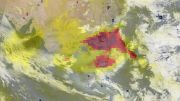
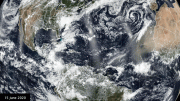
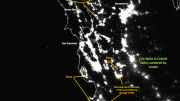
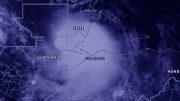
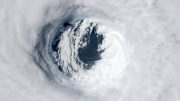
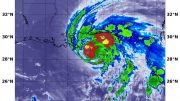
Be the first to comment on "NASA Analyzes Tropical Storm Dorian Day and Night"